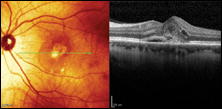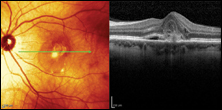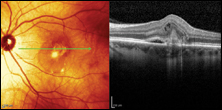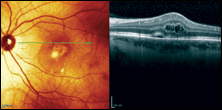Patient complains of progressive blur in one eye




A 51-year-old Caucasian female presented with a chief complaint of progressive blur in the left eye. She recalled being diagnosed with a retinal condition at a previous exam, attributed to interaction with chickens in the past. She was told the condition required regular monitoring with a dilated fundus exam.
Her medical history was remarkable for hyperlipidemia, gastroesophageal reflux disease and chronic migraines. Her medications included simvastatin 20 mg, omeprazole 20 mg and sumatriptan 50 mg.
Best corrected visual acuity was 20/20 OD and 20/80 OS (no improvement with pinhole). Pupils were equal and reactive to light with no relative afferent pupillary defect. Extraocular movements were full in each eye. Confrontation fields were full to finger-counting. The patient had difficulty with central fixation in the left eye, which was noted both during confrontation fields and refraction. Anterior segment findings were unremarkable, with deep and quiet anterior chambers and clear media. IOP was 16 mm Hg OD and OS.



Dilated fundus examination revealed a few discrete hypopigmented lesions of the outer retina without macular involvement of the right eye. The left eye demonstrated a greater volume of hypopigmented lesions with a concurrent juxtafoveal hemorrhage. The optic nerves, vasculature, vitreous and periphery were unremarkable in both eyes. OCT of the left macula revealed a neurosensory retinal detachment with hypo-reflective space with adjacent hyperreflective material. The right eye was unremarkable, with preserved foveal contour and retinal integrity. Fluorescein angiography revealed areas of parafoveal focal hyperfluorescence in the early phase, which did not increase in size and intensity in later phases in the right eye. The left eye revealed more diffuse hyperfluorescence at the fovea with increasing intensity in later stages.
What’s your diagnosis?
See answer on the next page.
The patient was diagnosed with punctate inner choroidopathy (PIC) with choroidal neovascularization. Multifocal choroiditis (MFC) and the ocular histoplasmosis syndrome (OHS) present very similarly but can be more easily distinguished by identifying a few key characteristics.
Punctate inner choroidopathy

PIC is an acute idiopathic inflammatory condition involving the RPE and outer retina. It is limited to the posterior pole and has no signs of intraocular inflammation. PIC is characterized by opaque, rounded spots with indistinct borders ranging 50 microns to 300 microns in size, which is typically smaller and more discrete than placoid lesions seen in other conditions such as serpiginous choroidopathy and persistent placoid maculopathy. These lesions are also associated with overlying subretinal fluid and serous retinal detachment. PIC typically affects myopes between the ages of 16 and 40 years with a strong female predilection (90%), according to Gerstenblith and colleagues.
Symptoms commonly include blurred vision, photopsia, central and/or peripheral scotomata and metamorphopsia, many of which correlate with the presence of choroidal neovascularization (CNV). CNV has been associated with PIC in up to 69% of 77 patients in a 2006 survey analysis (Kim et al.). Comparatively, CNV developed in 35 (9%) of 394 eyes of patients with presumed ocular histoplasmosis syndrome (POHS) in a 5-year prospective follow-up study in 1996 (Dolz-Marco et al.).
There is no consensus on the etiology of PIC. Choroidal blood flow was shown to decrease during the acute phase of PIC in one report, suggesting that changes to the choroidal circulation may contribute to its pathogenesis (Macular Photocoagulation Study Group). PIC has been proposed to be on the same continuum as multifocal choroiditis due to several shared characteristics, although PIC is almost exclusively relegated to posterior pole involvement. PIC typically presents without vitreous or anterior chamber inflammation with variable symptoms that may not correlate to fundus appearance. Uveitis with CNV with outer retinal lesions is more suggestive of multifocal choroiditis (MFC), sarcoidosis and white dot syndromes. Cases of recurrent PIC, which typically result in chorioretinal punched-out lesions, may erroneously be diagnosed as histoplasmosis.
Multifocal choroiditis
MFC has been described as a chronic bilateral condition characterized by several deep retinal punctate lesions with variable vitritis and anterior chamber inflammation. Like PIC, MFC typically affects young myopic females and has a high occurrence of choroidal neovascularization. In fact, MFC and PIC are largely considered the same clinical entity and are primarily differentiated by the extent of the lesions and presence of uveitis. MFC can present with vitritis and/or an anterior chamber reaction, and retinal lesions are typically diffuse, spreading out from the posterior pole to the periphery.
Causes of MFC are typically divided into infectious (POHS, tuberculosis, etc), non-infectious (ie, sarcoidosis) and idiopathic. Despite being considered the same clinical entity, PIC is still used to describe non-inflammatory states of MFC and may be regarded as a specific presentation of MFC.
Ocular histoplasmosis syndrome

OHS is a relatively common chorioretinal condition commonly characterized by peripapillary atrophy, punched-out chorioretinal lesions and the presence of choroidal neovascularization commonly attributed to Histoplasma capsulatum infection. Patients are typically diagnosed between the ages of 20 and 50 years, with no racial or sexual preponderance. Although H. capsulatum is distributed worldwide, the “histo belt” in the U.S. has the highest reported incidence. This area extends from Eastern Nebraska, Ohio and Southwestern Mississippi following the Mississippi and Ohio River valleys. Fowl are consistently identified as vectors for the infectious process, the spores becoming airborne from droppings (guano).
Differentiating PIC, MFC, POHS
MFC and POHS share several characteristics, which can make diagnosis confusing.
Both conditions are characterized by the presence of deep retinal lesions and CNV. A key diagnostic finding is the presence (MFC) or absence (OHS) of vitritis. As patients with PIC are usually myopic, peripapillary changes are commonly seen and may be mistaken for peripapillary atrophy secondary to scleral crescent. Additionally, scarring from lesions in PIC, in turn, give the appearance of the punched-out lesions synonymous with OHS. However, older lesions from PIC typically do not develop disciform scars as seen in OHS and are rarely sight-threatening when not involving the fovea. While the lesions in POHS and MFC are typically located throughout the retina, PIC lesions are relegated to the posterior pole and mid-periphery.
Considering the similarity in presentation, assessing the patient’s relative risk to H. capsulatum exposure may also aid in diagnosis. In this case, the patient reported playing with chickens in her backyard, thus making OHS a strong differential.
Treatment, management
Our patient was evaluated by a retinal specialist and treated for choroidal neovascular membrane with intravitreal bevacizumab and subsequently ranibizumab over the course of 6 months. Lab work was ordered to rule out infectious etiology including RF, CRP, ESR, ANA, ACE, lysozyme and histoplasmosis, which all returned negative. The CNV complex and subretinal fluid resolved, and the patient returned to our clinic with a best corrected visual acuity of 20/20 OS.
PIC is typically left untreated unless there is CNV involvement or macula-involving lesions. In cases without CNV, steroid treatment is used intravenously, orally and intraocularly to achieve more rapid vision recovery. There is no established standard for management of CNV in PIC, although anti-VEGF is commonly used as first-line therapy. Photodynamic therapy has been suggested in cases of non-resolving CNV to help maintain acuity and stabilize progression of CNV.
Spectral domain OCT, fluorescein angiography and fundus autofluoresence are often used to diagnose PIC in addition to fundus examination. Although the lesions seen in PIC and MFC have not been meaningfully distinguished from POHS lesions using these imaging modalities, they remain useful tools in determining the presence of CNV as well as monitoring for recurrence and progression. The advent of OCT angiography has shown promise in noninvasively detecting subclinical alterations in vasculature, allowing for improved detection of CNV, and has been shown to effectively characterize lesions at higher risk for neovascular conversion (Cheng et al.).
PIC is a rare condition typically limited to the posterior pole of the outer retina. Cases of PIC should be evaluated with serial OCT and intravenous fluorescein angiography to determine the presence of CNV. Due to the high incidence of neovascularization in these patients, PIC and MFC are important differential diagnoses in presumed ocular histoplasmosis syndrome. This is especially true in cases where H. capsulatum exposure is not suspected. Young to middle-age myopic females with punctate retinal lesions should be suspected for PIC or MFC and worked up appropriately.
- References:
- Brouzas D, et. al. Clin Ophthalmol. 2010;4:871-876.
- Campos J, et al. Med Hypothesis Discov Innov Ophthalmol. 2014;3(3):76-82.
- Cheng L, et al. Am J Ophthalmol. 2016;doi:10.1016/j.ajo.2016.06.029.
- Diaz RI, et al. Surv Ophthalmol. 2015doi:10.1016/j.survophthal.2015.02.005.
- Dolz-Marco R, et al. Ophthalmic Surg Lasers Imaging Retina. 2017;doi:10.3928/23258160-20170301-01.
- Gerstenblith AT, et al. Ophthalmology. 2007;doi:10.1016/j.ophtha.2006.10.047.
- Hirooka K, et al. BMC Ophthalmol. 2014;doi.org/10.1186/1471-2415-14-73.
- Kim EL, et al. Ophthalmic Surg Lasers Imaging Retina. 2017;doi:10.3928/23258160-20170928-02.
- Macular Photocoagulation Study Group. ArchOphthalmol. 1996;doi:10.1001/archopht.1996.01100130669006.
- Munk MR, et al. Retina. 2015;doi: 10.1097/IAE.0000000000000370.
- Niederer RL, et al. Ophthalmology. 2017;doi:10.1016/j.ophtha.2017.09.002.
- Ryan S, et al. Retina. 2013. London: Elsevier Saunders.
- Spaide RF, et al. Retina. 2013;doi:10.1097/IAE.0b013e318286cc77.4.
- Tavallali A, et al. J Ophthal Vis Res. 2016;doi:10.4103/2008-322X.194141.
- Thuruthumaly C, et al. Curr Opin Ophthalmol. 2014;doi:10.1097/ICU.0000000000000100.
- For more information:
- Jim Williamson, OD, is the residency supervisor at the Memphis VA Medical Center. He can be reached at: jim.williamson44@gmail.com.
- An Vo, OD, is a resident at the Memphis VA Medical Center. He can be reached at: an.vo.opt@gmail.com.
Disclosures: The authors report no relevant financial disclosures.
